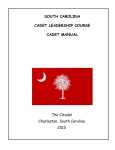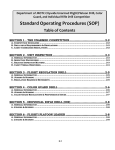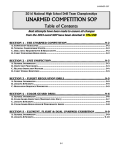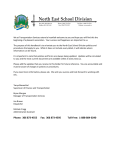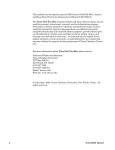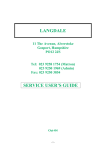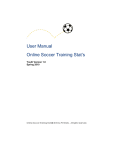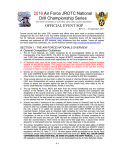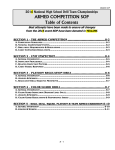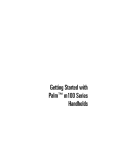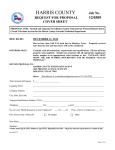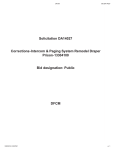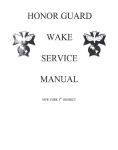Download 2014 CLC_BASIC CADET MANUAL
Transcript
SOUTH CAROLINA CADET LEADERSHIP COURSE BASIC CADET MANUAL The Citadel Charleston, South Carolina 2014 12 May 2014 South Carolina Cadet Leadership Course Cadet Manual CADET MANUAL INDEX I. General Rules 3 II. Cadet Discipline 4 III. Procedures 5 1. 2. 3. 4. 5. 6. 7. Schedule Mess Hall Physical Training Road Guard Campus Barracks Beach 5 5 6 7 7 7 8 IV. Personal Inspection Standards and Procedures 9 V. Barracks/Room Inspection Standards 10 1. Guidelines 10 10 2. Room Evaluation Sheet 3. Diagrams 13 14 15 16 Room Evaluation Form Bed Arrangement Diagram Press Arrangement Diagram Inspection Drawer Diagram VI Physical Training Requirements/Procedures 17 VII. Excellence / Discrepancy Report (Form 341) 18 VIII. Drill Requirements/Procedures 1. 2. 3. 4. 18 Drill Evaluations Evaluation Form Drill Pad Expanded 30 Commands 18 19 20 20 IX. Evaluations and Scoring 23 X. Awards 24 XI. Helpful Hints for CLC Cadets 26 XII. CLC Packing Checklist 27 Page 2 12 May 2014 South Carolina Cadet Leadership Course Cadet Manual CADET LEADERSHIP COURSE BASIC CADETS. The goal of CLC is to instill the principles of teamwork, leadership and effective communications while enhancing in each a sense of self-confidence, self-respect, and self-discipline. This is accomplished using a combination of adventure training, team challenges, physical fitness training and discipline drills. This training will evolve you into a different person than when you started. As a basic Cadet you will be exposed to a full day of leadership and teamwork activities that will help you develop skills in time management, attention to detail, leadership, and teamwork. You will learn how to be an effective team member to be better prepared to lead at your home unit. You will leave the CLC with a stronger sense of purpose and mission. You will know how to achieve success in any training environment. This week will involve you keeping a demanding schedule of academic and physical challenges. You will be constantly evaluated on how well you stand-up to and perform on these conditions. You will gain the confidence of a team member and better understand what it takes to become a leader. I. GENERAL RULES AND CONDUCT EXPECTATIONS 1. Cadets attending the Cadet Leadership Course are expected to learn, retain, and take back to your units, concepts of leadership and teamwork to better create your unit flight and group staffs. This course is not designed to teach you how to write a point paper or how to work on a project but to understand teamwork and what it takes to stand out and take charge of your element or flight. 2. Cadets are specifically selected to attend the Cadet Leadership Course (CLC). They are expected to be the best representatives of their course's JROTC programs. As such, their behavior is expected to be of the highest standards, reflecting pride, honor, and integrity upon themselves, their respective courses, and the United States Military Service they represent. 3. Cadet behavior standards are established to provide for the safety and welfare of cadets as well as promote orderly, efficient conduct of the course. CLC is an opportunity for selected cadets to learn skills that will increase their leadership potential within their unit, as well as increase their success in a military career or as a citizen of our country. a. Any cadet behavioral problem distracts from the time and efforts of the instructors, cadre, and other cadets. Problems should be prevented when possible and dealt with fairly and quickly when they occur. b. The Flight Advisor will investigate all reported cadet conduct violations and coordinate with the Director and home unit instructors. They will make recommendations for action; however the Director and home unit instructors will make final decisions on the action to be taken. 4. All cadets will be briefed by their unit instructors regarding CLC behavior standards prior to attending CLC. In addition to following the specific rules listed, cadets should use common sense and realize that any behavior that reflects badly upon themselves, their courses, or their uniform is unacceptable. 5. Cadets who give their maximum effort during the brief training periods at CLC will find their efforts are personally rewarding, and will have fond memories of CLC for a lifetime. 6. Cadets will be evaluated in many areas during CLC. The following procedures in this handout are to be used in these areas. Review this material before arriving at CLC. This material is testable. Talk to your instructor if you have any questions or do not understand any of the procedures. Page 3 12 May 2014 South Carolina Cadet Leadership Course Cadet Manual II. CADET DISCIPLINE 1. Minor offenses may be handled with verbal corrections or use of the CLC Form 341 (see handouts on use). 34l discrepancies will lower the score of the individual and flight for CLC competition and awards. The Director, Flight Advisor, and home unit instructor will deal with major offenses. Unacceptable behavior will result in dismissal from CLC. Additionally, any cadet who cannot participate in all activities for physical or mental incapacitation will also be removed from the course. a. Attitude: Demonstrate a positive attitude at all times. If you get discouraged after a minor failure or poor performance in an area, it will send the signal that you give up too easily and lose confidence – just the opposite of what leaders should do. 1) Negative attitudes will stand out quickly. They will be dealt with just as quickly. If you keep a positive attitude all week – even with some disappointments – you will grow as a leader and have a very rewarding week. 2) Indifference to training. Basic cadets will follow the directions of cadet flight commanders, cadet cadre and instructors. Cadets who do not follow directions and talk back to cadre as such will be removed from training and sent home. b. Safety: Your personal safety is the most important priority at this school. Each activity will be completed in a safe manner; therefore, weather, especially high temperatures and thunderstorms, will impact every training decision. Plan to be flexible if severe conditions force us to change the daily schedule. Horseplay and dangerous activities, especially in the barracks will not be tolerated. Conduct yourself maturely all times or win a free trip home. c. Personal appearance: The standards at CLS are exactly the same as those prescribed by AFJROTC instructions. The Standardization Evaluation (Stan Eval) team will evaluate all phases of training according to Air Force standards – no exceptions. Spend ample time attending to this aspect of your performance. It will affect your “standing” at the end of the week. Uniform and grooming standards are detailed in this Guide. Read them just to make sure you understand what is expected of you. d. Military customs and courtesies: This is a military leadership school; therefore, we expect you to observe all military customs and courtesies. Salutes will be rendered in all places except formation and training areas. While marching as a flight, the Cadet Flight Commander will salute for the unit. At all other times, cadets will salute Air Force officer instructors in uniform. Salutes are also rendered when instructors are in the instructor CLC utility uniform (CLC blue polo and hat) even if rank cannot be determined. We will pay full honors and show appropriate respect for the flag at all times. Military personnel are polite and courteous at all times. We are held in high regard by the staff of The Citadel. Let us continue to earn that respect 2. Cadet Conduct a. All cadets are bound by the cadet honor code. “I will not lie, cheat, or steal, nor tolerate those who do.” b. There will be no intimate contact or public displays of affection between cadets at any time. This includes holding hands, kissing, and embraces. c. No drugs, alcohol, or tobacco will be used or possessed by any cadet. d. Cadets will not use profane or inappropriate language at any time. e. Cadets will not have contact with non-CLC personnel until after the awards ceremony and graduation. f. Cadets will not use the telephone until approved by the Director or home instructor. Chaperons are not authorized to give permission to make phone calls. Your instructors will keep your phones and make them available only if absolutely necessary. Inappropriate use of cellular phones will be reported to the Director. Instructors will be vigilant for violations. Any cadet Page 4 12 May 2014 g. h. i. j. k. l. m. n. o. p. q. r. South Carolina Cadet Leadership Course Cadet Manual found with a phone (on or off, charged or dead batteries) will be dropped from the course and sent home. Home Unit Instructors will take full charge of these students at this time. All electronic devices to include paging devices, cellular phones, radios, CDs players, MP3-4 players, Ipods, and Ipads or any device electronic or otherwise that outside communications or gaming might take place, are prohibited at CLC. Cadets caught with unauthorized devices jeopardize their flight’s honor flight standing and will be removed from training and sent home. You are not authorized to have a radio alarm clock. Cadets will not have cars on the campus unless specifically authorized by the Director. Cadets with authorized cars will turn in keys to their home unit instructor. Cadets will eat properly and drink at least two glasses of water or fruit juice at each meal. All soft drink and candy machines are off limits until authorized by the Director. Cadets will not have candy or snack foods in the barracks. Cadets are not authorized to purchase candy in The Citadel gift shop or use the cadet snack bar without permission from the Director. Cadets will not use the cadet canteen or The Citadel gift store until authorized by the Director. Cadets will immediately report any problem within their flight to the Flight Cadre or Flight Advisor. Less serious matters should be reported to the Cadet Flight Commander. Cadets will display proper respect to the flag, anthem, and uniform at all times. Cadets will be on time to all scheduled activities and will fully participate. Sexual harassment or bullying will not be tolerated. Any violation will result in loss of position and dismissal. Cadets will display a positive attitude and a spirit of cooperation at all times. Absolutely no hazing, harassment, or physical or verbal abuse will be tolerated. Cadets will not wear hats of any kind in any building while at CLC. III. PROCEDURES 1. Daily Schedule: One of the keys to success at CLC is time management. All flight and support cadre cadets will be provided a daily schedule. Cadre cadets are expected to adhere to this schedule at all times to ensure they and their flights are on time to all activities. By being on time and planning ahead you can maximize your potential and performance. 2. Mess Hall Procedures a. Basic Cadet Procedures. Flights enter the mess hall with absolutely no talking. Basics are not allowed to talk at anytime in the mess hall except when addressed by a cadre or instructor. The Guidon Bearer will be the first in and will position the guidon next to the exit door. Each flight will proceed to their assigned tables. The group commander will call the mess hall to attention and a moment of silence and thanks will be observed. The group commander will give the command, “Rest” after which flights will begin to move to the serving lines. Flights will remain at their tables and the food will be brought to the tables if the family style dining is used. b. Serving lines only. There will be two speed serving lines. Assigned tables on the right will proceed to the serving line on the right. Left side tables will proceed to the line on the left. Tables in the middle will have the right half go to the right and the left half will go to the left. Cadet cadre will be assigned to tell the tables when to proceed to the line to keep it moving as efficiently as possible. c. Serving lines only. Basics will come to attention, and move through the line as in marching. At any halted position, basic cadets execute a sharp “Parade Rest” and will have the Basic CLC Handbook in the left hand studying at the position of “Parade Rest”. Basics will put the CLC Handbook away once they enter the immediate serving line. d. Serving lines only. Once the basic cadet has received their food, they will move to their assigned flight table, place the tray on the table and remain at parade rest until each seat is occupied on Page 5 12 May 2014 South Carolina Cadet Leadership Course Cadet Manual their mess. Cadre flight commanders and deputy flight commanders will sit at the end of the tables with their flights to ensure all basics are eating and drinking sufficient liquids. Support cadre will fill in as needed to have cadre at the ends of each table. Once the mess is full, basics and flight cadre will sit and begin eating. e. All cadets will sit straight in their chairs during the meal and will not lay their heads on the table at anytime. Basic and cadre cadets will use proper table manners and will not place their elbows on the table or “wolf their food down.” f. Cadets throwing food across the table at another cadet or on the floor will be dealt with harshly up to and including dismissal from the school. g. Cadets will have 20 minutes from this time to eat after which the group commander will call the mess to attention. Cadets will come to attention in their seats. The group commander will pass any announcements and changes to the schedule. He will again give the command “Rest”. This is known as, “Second Rest”. After second rest, cadets may finish their meal. Once the flight has finished, the flight commander will move the flight to the next activity to arrive on the scheduled time. Flight commanders will ensure that all basic cadets have sufficient food and drink at least two glasses of liquids before leaving the mess hall. h. Operations and Support Cadre Procedures. Group Staff will sit at the Group staff table. Other operations and support cadre may fill in seats as available. Fill all tables and use as few tables as possible. Flight commanders and deputy flight commanders will sit with their flights on the end seats. Support cadre will fill in and sit on the end seats of tables as needed. Serving lines only. Cadre will not break into the serving line and step in front of basics. i. Once the flight commander has deemed that all basics have completed the meal, all basics will leave the mess hall in an orderly fashion and fall-in flight formation to march to the next activity. 3. Physical Training Procedures a. Cadets will arise each morning according to the published schedule on the “First Call” bugle call. Flight commanders and deputy flight commanders are responsible to ensure that all members of their flight are awake and preparing for PT. All cadets will participate in physical training. The night duty officer will check rooms after PT formation to ensure that no cadet inadvertently slept in. b. Cadets are not required to wear a special PT uniform but will wear appropriate gym shorts, tee shirts, socks and running shoes. c. Upon the sound of the “Reveille” bugle call, the group commander will call the squadrons to attention. Cadets will perform various exercises on the quad to include pushup, sit-ups, and stretching prior to the 1 mile fun runs. d. Cadets will run a measured mile for time during the first morning at CLC. Male cadets must run the mile in 9 minutes or less and females in 11 minutes or less to qualify for any awards at CLC. e. Schools competing for the Van Eaton Award (100% pass rate) will run a measured mile for time. All male cadets must run the mile in 8 minutes or less and females in 10 minutes or less to qualify for the Van Eaton Award. Instructors will certify that all cadets from their unit participate. This time will also count for the AFJROTC PT ribbon. f. Command Cadre and Flight Cadre that do not pass the PT test and meet the Van Eaton Award criteria for the measured mile run (male 8 minutes, female 10 minutes) will be removed from their position and be reassigned as a basic plus. Instructors have the option of sending these cadets home. Page 6 12 May 2014 South Carolina Cadet Leadership Course Cadet Manual 4. Road Guard Procedures a. Each road guard will be issued a reflective vest. Four (4) per flight, rotating daily. b. Two will march at the front of the flight and two will march in last file to the rear, behind the flight sergeant. c. Road guards will not enter an intersection or active driveway without the permission of person in charge of the flight. The person in charge will halt the flight and instruct road guards where to stand prior to crossing a street, unless an instructor tells them otherwise. d. Once front road guards are in place and the flight is given “Forward March,” the rear road guards double time to the front of the flight and replaces front road guards by tapping them on the shoulder. Rear road guards will be called in by one of the Cadre Flight Commanders. e. All road guards return to original positions once relieved. 5. Campus Procedures a. Basic cadets are not allowed to wander the campus unsupervised unless given specific permission from an instructor and must be accompanied by the instructor or cadre cadet. b. Groups of cadets (three or more) must march as a unit anytime they are proceeding to or from an assigned activity. Cadets must maintain cadence at all times. Units may proceed at double time only when in proper running uniforms and they maintain the integrity of the flight. Cadets will not run while in the duty (AF blue service) uniform. 6. Barracks Procedures a. Cadets will remain in their barracks room between “taps” and “reveille” except for emergencies or to use the latrine. b. Cadets will be notified by the public address system and/or fire alarms if emergency conditions arise that require barracks evacuation. 1) Fire evaluation: Cadets will leave rooms and proceed to the nearest stairwell and down to the quad. All cadets will leave the barracks by the front sallyport and muster at least 200 feet in front of the barracks. Stay in your respective flights so the flight commanders can get a headcount. 2) Severe weather other than thunderstorm: All cadets will evacuate to the first division and remain undercover until danger is past. c. Basic cadets will use only assigned stairwells to and from their division. Padgett-Thomas barracks have a middle stairwell at the front sallyport. This stairwell is restricted to instructor personnel only. Basic and cadre cadets are not authorized to use this unless accompanied by an instructor. Cadets will not venture up any stairways above fourth division or onto any roof areas. d. Cadets will not be in the room or division (floor) of a cadet of the opposite sex at any time. Any violation will result in loss of position and/or dismissal. e. Basic cadets are not allowed to be on the galleries at anytime unless on official business and under the direct supervision of the flight commanders. Basic cadets at no time will stand next to or hang over the railings. f. Basic or cadre will not run on the galleries, stairs, quad or any area inside the barracks area. Extreme care must be taken if surfaces are wet. The quad is very slippery when wet. g. Basic cadets will not congregate in one room (not more than four cadets in two person room or six in a four person room) unless under the direct supervision of cadre or flight commander. Page 7 12 May 2014 South Carolina Cadet Leadership Course Cadet Manual h. Cadets will take care of their assigned barracks, room and all furnishings. Occupants of the rooms will pay for any damages incurred. Cadets will not flush any foreign objects down latrine toilets. Feminine hygiene items will be disposed of properly in waste containers. Do not flush these items. i. Cadets should not have valuables in their room. CLC is not responsible for lost items. Leave large amounts of money and jewelry at home or with your home unit instructor. j. Personal preparation time is after the last scheduled event of each day. At this time you are to: 1) Prepare room for the next scheduled room inspection. 2) Prepare uniform for next scheduled inspection. 3) Follow cadre for shower instructs. All basics will shower at least once each day. a) Basics shower schedule is from 2030-2115. b) Cadre shower schedule is from 2130-2200. 7. Beach Procedures (if applicable) a. Transport and Arrival 1) Cadets and Instructors will board buses as designated by the bus rosters. Rosters will load buses by flights and flight advisors will be attached to their flight. There will be at least three instructors per bus. Cadets must depart on the same bus that they come on. Roll will be taken by use of the rosters before departing The Citadel and before departing the beach house. 2) All cadets should have a change of clothes (extra shorts for the ride back). Females may wear one piece or modest two piece bathing suits. Female cadets will be checked for proper attire by a female chaperon prior to departing for the beach. Cadets with inappropriate swimwear will be instructed to put on shirts and shorts during the beach trip. All cadets will wear shirts and shorts and beach shoes or flip-flops during transport. 3) Cadets will unload, upon arrival at The Citadel beach house, and remain with their flight until released to the beach. No one will be permitted on the beach until instructors and lifeguards are in place. Cadets are prohibited from going on the beach unless instructors are present on the beach. Cadets are prohibited from going into the water unless lifeguards are present on the beach site. Lifeguards give the signal to enter the water. 4) All cadets should bring and use sunscreen. (There will also be sunscreen provided by CLC). Instructors and cadre will be on the lookout for basic cadets who might burn easily and ensure they are protected. It is a sign of poor judgment should you decide not to use sunscreen and incur severe sunburn. This could jeopardize your graduation from CLC. b. Beach House Area 1) The area in use by the CLC is the covered picnic area (the shed) and the grounds around the beach house to include the sand volleyball court. Restrooms are located on the outside of the beach house. Cadets and instructors are not authorized to enter the main floor of the beach house. 2) The beach area is defined as the area in the front of The Citadel beach house property and a 10 minute walk in either direction. The swimming area is defined as the water area directly in front of The Citadel beach house property. 3) Cadets may walk along the beach in small groups but are prohibited from entering the water in any location except for the front swim area of the beach house. Cadets are not to walk more than 10 minutes from the beach house in either direction and are prohibited from going in the water during walks. Cadets must be present for the picnic and organized games. Page 8 12 May 2014 South Carolina Cadet Leadership Course Cadet Manual 4) Cadets are prohibited in the water unless lifeguards are on duty and instructors are in the immediate area. There will be a minimum of four instructors directly monitoring cadets during swimming. 5) The director and deputy director will ensure that a ratio of one instructor/lifeguard per ten cadets is maintained at all times that cadets are in the water with the minimum ratio of 1 lifeguard per 25. For example; three lifeguards and 4 instructors must be present if 70 cadets are in the water. 6) Cadets will not get involved in horseplay in the water. Cadets will not enter water deeper than their mid waist. 7) Standard beach signals. All lifeguards and instructors will take a whistle to the beach area. The following signals apply. 1 whistle blast = Swim (cadets may not enter the water unless permission is given) 3 whistle blasts = Out too far (cadets will be motioned to return to shallow water) 5 whistle blasts = Emergency (exit the water immediately without question) IV. PERSONAL INSPECTION PROCEDURES AND STANDARDS 1. “Open Ranks” Personal inspections are scheduled in the mornings. Basic cadets are expected to “be on the line on time.” All cadets will fall-in on the quad by flight formation. Flight commanders will have their flights ready for inspection prior to the scheduled time. 2. Flights will “open ranks” prior to the inspector’s arrival. The inspector will inspect the flight commander and deputy flight commander prior to inspecting basic cadets. The commander will precede the inspector and the deputy flight commander will follow the inspector and take the report. 3. The following form example will be used for the inspection. PERSONAL AND UNIFORM INSPECTION FORM 80 max pts) Total (10 pts ea.,) Military Image Headgear Personal Grooming Accouterments Uniform Cleanliness Uniform Wear Name Footwear Date Inspector Position of Attention Flight Remarks (Example Only, Do not use) 4. Graded inspection areas: a. Positions of attention: this means the position as described in the Air Force service manual for drill and ceremonies. Cadets talking in formation will receive maximum deduction of 10 points. Cadets moving around will receive a deduction of points. b. Footwear: this means authorized military or commercial equivalent footwear that is clean, safe, highly shined and laced properly. (no corfam shoes for basic cadets unless this is a Page 9 12 May 2014 South Carolina Cadet Leadership Course Cadet Manual standard issue for basic cadets at that unit). Footwear such as socks and hose will be included in this standard. c. Uniform wear: this means the uniform should be neat, correct in design and specifications, fitted properly, pressed and in good condition (that is, not frayed, worn out, torn, faded, patched, and so forth). Uniform items are to be kept zipped, buttoned, snapped, or attached with Velcro. Gig line - when shirt is worn tucked into trousers or slacks with front fly opening, the button front edge of the shirt, the outside edge of the belt buckle, and the edge of the fly will align. This alignment creates a "gig line". The gig line is to be straight and neat. Wear specifications include trouser/slacks/skirt length. Undergarments should be in accordance with Air Force service uniform instructions. Belts worn backwards will receive maximum deduction of points. d. Uniform cleanliness: this means the absence of lint, dust, hair, dirt, stains (to include perspiration, cosmetics and hair preparations), and "ring around the collar". e. Accoutrements: this means ribbons, insignia, badges; emblems, tags and so forth, authorized for wear on uniforms prescribed by each service and JROTC instructions. Cadets not wearing name tags and ribbons will be scored under failure to wear prescribed items and have maximum item points deducted from inspection score. f. Personal grooming: this means beards (male), cosmetics (female), hair - overall standard (m & f), hairstyles (m & f), mustache (male), sideburns (male), wigs and hairpieces (m & f), and nail polish (female) as prescribed by the Air Force uniform standards. Males not shaving will receive maximum deduction of 10 points. Males, not shaving for the second time will receive a zero for inspection and turned over to school instructor. Females and males will not have any unnatural hair coloring. g. Headgear: authorized flight or duty caps. Berets and wheel hats are not authorized for inspection wear or the awards parade. h. Military image: this means wearing the uniform altered to fit properly, neat, clean and pressed and accouterments as prescribed by Air Force standards. This excludes the extreme, the unusual, and the fad. Any wear of prohibited items such as white socks, sunglasses in formation, items protruding from pockets, excessive jewelry, etc., which detracts from proper military image, should be scored under this standard. V. BARRACKS/ROOM INSPECTION STANDARDS 1. Barrack Inspection Guidelines. The barracks inspection guidelines should be used by all cadets to insure compliance with instructions and by inspectors to insure overall consistency. 2. Room/Barracks Evaluation Sheet: The Room Evaluation Form (Form 4) is to be placed on the center of the pillow (secure it with a piece of masking tape or tuck it under edge of pillow in plain sight of the inspector). The blanks for Name, Home Unit, Date, Barracks number and Flight must be filled out completely (no nicknames). If the form is not present, the evaluation score for that day will be ZERO. (Note: Items not available for display in locker or other discrepancies will be annotated on form so that points will not be deducted. Ex: annotate, No hairdryer, if you do not have one. This does not apply to required items such as sunscreen.) a. Nametapes. Nametapes must be placed on various articles to identify the specific cadet’s use. Use masking tape (cut evenly, not torn) or other labels provided by your Cadre for nametapes. Put tapes on the top center of each item being identified. Tapes will be placed on press (locker) door and on bed rail below and centered on the 6 inch white collar of the top blanket/sheet. Clearly print the last name and first initial of the cadet. Page 10 12 May 2014 South Carolina Cadet Leadership Course Cadet Manual b. Beds. Cadets will bring the bedding items outlined in this paragraph to CLC. Beds will be made according to instructions provided to Cadre Cadets. The top sheet must be a white, flat sheet that will fit a single bed. The bottom sheet should also be a flat sheet. The flat sheet (when used as a bottom sheet) will tightly form a 45-degree angle. A solid color blanket (preferably a dark color) will cover the top sheet with 6” of the top sheet folded back over the blanket, forming a dust cover to the end of the bed. A standard pillow with white pillowcase must be grounded against the head of the bed, stopping at the end of the mattress. The pillowcase will be smooth across the pillow, with excess material folded under the pillow. The pillow opening will face towards the wall. The top occupant’s headboard/pillow will be nearest the door of the room; the bottom occupant’s headboard/pillow will be nearest the window. Beds will be grounded against the wall. (See Room Inspection Diagrams.) c. Shoes. All shoes will be placed at the foot of the occupant’s bed. No shoes, military or civilian, will be left in the lockers or presses. Shoes will be grounded against the bedpost and each other. Do not leave blank slots in the shoe arrangement. Shoe toes must be pointed out, and all toes must align across the width of the bed and even with the edge of the bedpost. (See Room Inspection Diagrams.) d. Towel and Washcloth. The towel and washcloth must be white. They will be single-folded evenly lengthwise and hung on the footboard, with the folded side towards the center of the room and the two edges toward the wall. Both will be hung with one inch from the end of the fold to the bedpost. The washcloth will be the closest to the center of the room. (See Room Inspection Diagrams.) e. Inspection Drawer. A white towel will be used to cover the bottom of the drawer. It will be folded to fit the inside of the drawer smoothly with excess material folded under. Refer to the Room Inspection Diagrams for arrangement of articles in the drawer. If an item is pictured at the edge of the drawer, it must be grounded. If an item is not pictured, it should not be there (i.e., put it in the personal drawer). The inspection drawer will be left open 6 inches (inside measurement) to allow an inspector to view contents of drawer without disturbing them. f. Lockbox. The lockbox or personal drawer is designed to hold valuables. Whether valuables are placed in the lockbox or not, it must be locked! Do not leave valuables unsecured in any room under any circumstance! g. Large Closet (Press). Items will be arranged as indicated in Room Inspection Diagrams, starting from the left with 1 inch between hangers. The front of all clothing items will face left. Trousers will be hung with pant legs facing left, zippers out, edges even. Skirts will be hung in a like manner. All buttons (except top shirt button) will be buttoned, and zippers will be zipped. Place the laundry bag at the lower left and luggage at the lower right. No items will be thrown into the bottom of the locker. All items are grounded except for hang-up clothes. The inside of the locker must be clean and free from any dust or dirt. Units should bring extra clothes hangers. h. Room Trash. Each room must have a wastebasket, and it must be free of trash. Both roommates receive the same point deduction if this is not accomplished. i. Furniture. All furniture must be free from miscellaneous objects, dust, and dirt. Mirrors and sinks should be clean and free of hair and water. Both roommates receive the same point deduction if this is not accomplished. j. Window Ledge. Window ledge area will be free from dust and dirt. Both roommates receive the same point deduction if this is not accomplished. k. Floor. Floor must be clean of all lint, dust, and dirt. This includes under the beds. Both roommates receive the same point deduction if this is not accomplished. Page 11 12 May 2014 l. South Carolina Cadet Leadership Course Cadet Manual Name Cards. Name cards must be filled out properly (printed neatly, using block/capital letters) and attached to the outside of the door as directed. Both roommates receive the same point deduction if this is not accomplished. m. Outside Area. The area immediately outside of the each cadet’s door must be swept clean. If an area in front of several rooms has excessive trash and dirt, all rooms will be assessed the same number of points. All galleries in the flight’s area should be swept daily and free of trash. All flight members will have points deducted if not done properly. n. AC Fan/Lights Left On for Inspection Only. Both roommates receive the same point deduction if this is not accomplished. Inspectors will turn off lights. The room air conditioner fan switch will be LEFT ON at all times. Don’t cut them off or you will roast. 3. Showers and toilets will be swept daily. Cadets do not clean the showers however there will be no trash or soap on the floors. 4. Valuables. At no time will valuables be left unsecured in any area of the room or barracks. Note: All flight members receive the same point deductions for discrepancies in common areas. 5. Check-out procedures. After the awards ceremony when cadets are ready for room inspection they will: 1. Have all drawers open for inspection. 2. Stand outside their door grounded against the wall. 3. After an instructor clears the room, cadets will move forward and stand against the rail. 4. Remain at the rail until all cadets are released. All cadets will be released at the same time. 6. Instructors will check all cadet rooms to insure that they are not damaged and that all items belonging to cadets are removed. Barracks and rooms will be left neat and orderly. Following barracks inspection, cadets will be released to their home instructors. Page 12 12 May 2014 Name South Carolina Cadet Leadership Course Cadet Manual ROOM EVALUATION FORM (EXAMPLE ONLY, DO NOT USE) ___________________________ Home Unit ______________________________ PRINT (LAST, FIRST) Room # ___________________________ Flight _____ Inspection Date __________ Deduction -5 1. Door cards properly filled out and displayed on door. 2. Room evaluation form completed correctly and placed on the pillow -5 3. Proper nametapes on bed _____ press______ -5 4. Bed improperly made -2 to -6 5. Shoes not properly displayed -2 to -6 6. Wastebasket dirty or missing -3 7. Towel/washcloth improperly displayed -3 8. Dust on bed, press, and window area. -2 to -6 9. Male inspection drawer Soap dish Shaving Cream After shave Hair Brush/Comb Razor _______ Toothbrush _______ Sunscreen _______ Shampoo _______ Deodorant Toothpaste -2 to -20 10. Female inspection drawer Soap dish Hair Brush/Comb Cosmetics Perfume ___ Razor _______ Toothbrush _______ Sunscreen _______ Shampoo _______ Deodorant _______ Toothbrush _______ - -2 to -20 11. Clothes not displayed properly in large press, Shelves not properly arranged. -2 to -20 12. Valuables left unsecured -25 13. Lint, dirt, dust on floor. -3 to -5 14. Beds not grounded on wall correctly -2 to -4 ______ Total Points Deducted Maximum points possible 100 – total points deducted = Note: No form on bed results in a grade of ZERO for that day. _______ Score Inspector's last name ______________________ Form 4 Page 13 12 May 2014 South Carolina Cadet Leadership Course Cadet Manual Page 14 12 May 2014 South Carolina Cadet Leadership Course Cadet Manual Page 15 12 May 2014 South Carolina Cadet Leadership Course Cadet Manual Inspection Drawer Arrangement White towel must cover bottom of drawer. All items must be grounded on side or front of drawer as shown. All items must be displayed. Cadets should have all items displayed. Drawer opening must be 6 inchers for inspection. Page 16 12 May 2014 South Carolina Cadet Leadership Course Cadet Manual VI. PHYSICAL TRAINING REQUIREMENTS 1. General. CLC is a strenuous, stressful experience. CLC attendees must meet a minimum standard of physical fitness. Cadets coming to CLC should be able to run the mile in at least 9 minutes for male and 11 minutes for female. Also cadets should be able to perform at least 30 sit-ups and 15 pushups (females) and 30 pushups (males). It is strongly recommended that cadets also be able to do pull-ups and flex arm hangs as part of the training prior to coming to CLC. The CLC Physical Fitness program is divided into two areas: Physical Fitness Training and Athletic Competition. 2. Physical Fitness Training a. Warm-up. Each morning, all cadets will be led through a series of warm-up and stretching exercises prior to physical training. b. Schedule. The time and location for physical training and testing will be published on the daily schedule. c. Equipment Required. It is recommended that cadets wear PT clothing (appropriate civilian-type shorts and T-shirts—tucked in tightly at front, sides, and back). PT shorts should be of reasonable length. PT tee shirts must have sleeves. No shirts with cut off sleeves. White socks will be worn whenever in PT uniform. No excessively short or long shorts will be worn. d. Procedures. After flights have fallen in, the Fitness Instructor or cadet cadre will conduct warm-up, stretching, and strength building exercises. No cadet should attempt any warm-up exercise that might cause injury or aggravate an injury. Home school instructors will be informed if you cannot perform physical training. Cadets not able to participate in PT will be removed from training. The following daily procedures will be followed: 1) Flights will remain in the barracks quadrangle or march to the PT field and form a large formation as directed by the PT instructor. 2) Cadets will extend intervals and square up the PT formation. All cadets will participate and “count off” as the exercises are performed. 3) Cadets will be given a reasonable amount of recovery time between sets of exercises. 4) Exercises will progress from the easiest to the most strenuous. e. Proper Testing Positions. 1) The PT test will be given on the first morning after cadets arrive. It is imperative that cadets come to CLC in good shape and ready to take full advantage of the training. 2) The PT test consists of pushups, sit-ups, and the one-mile run. These activities may vary from year to year. 3) Push-ups for Male and Female Cadets. Cadets will perform push-ups with the body in a relatively straight, inclined position. The cadet’s entire body will lower until there is a 90 degree angle at the elbow and then straighten fully. The back should remain virtually straight throughout this exercise. Male cadets are expected to do a minimum of 30 push-ups within 2-minutes and female cadets are expected to do a minimum of 15 pushups within a 2-minute period. 4) Sit-ups. Both male and female cadets will perform this exercise with arms crossed over the chest, legs bent at a 45 degree angle with the feet flat on the floor. From the prone position, cadets come up far enough to touch the forearms on the front of the thighs and lower the body until the small of the back touches the ground. Rest for only five seconds in the up position. All cadets are expected to do a minimum of 30 sit-ups within 2 minutes. 5) Mile Run. All cadets will run the mile each day. To pass the PT test, males must run the mile in Page 17 12 May 2014 South Carolina Cadet Leadership Course Cadet Manual 9:00 or less and females in 11:00 or less. 6) Van Eaton School Award. To qualify for the Van Eaton Award all cadets from the home unit must run the mile in 8:00 or less and females in 10:00 or less as well as pass the push-up and situp portion of the evaluation. The unit must have a minimum of 10 cadets to qualify. f. Scoring Procedures. Instructors will time and record the mile run. Time will start once the last cadet crosses the start line and end when each cadet crossed the finish line. Times will cease being called after 11 minutes. VII EXCELLENCE/DISCREPANCY REPORT 1. A 341 form will be carried on both cadre and basic cadets at all times when in uniform. a) Cadet Military Uniform: The 341 form will be folded twice (lengthwise); the tip of the form will then be folded approximately 1 inch so that the form can be carried in the brim of their flight caps. b) Utility Uniform: When cadets are in the utility uniform the 341 will be the left pocket of their shorts or in a pocket on their camel back. 2 Cadets will be responsible for filling out the top portion of the 341 with their name, grade (cadet rank), organization (course) and flight. Cadre and instructor staff are the only ones authorized to "pull a 341" (to request a 341 from a cadet) for the purpose of documenting a job well done or for making a correction. Forms must be filled out completely once pulled and given to the Flight Advisor, who in turn will give all forms to the CLC Evaluation Officer. All 341s will be given to the home course instructor at the conclusion of CLC. EXCELLENCE/DISCREPANCY REPORT LAST NAME-FIRST NAME-MIDDLE INITIAL GRADE ORGANIZATION CLASS/FLIGHT (If Applicable) EXCELLENCE/EXHIBITED DISCREPANCY (Be Specific) TIME AND DATE PLACE PRINTED NAME OF REPORTING INDIV SIGNATURE OF INDIV REPORTING Form 341 VIII DRILL PROCEDURES (30 COMMAND DRILL EVALUATION) 1. All basic cadets will be evaluated in control of a flight by means of military drill using the AFJROTC 30 commands. Cadets will be able to practice several times during the week with the flight, however, little time is given to learn the commands during CLC. It is imperative that all cadets be able to march the flight in the 30 commands prior to arriving at CLC. Page 18 12 May 2014 South Carolina Cadet Leadership Course Cadet Manual 2. Cadets will march in a 3 by 3 formation using a 65 foot by 65 foot drill area. Cadets are evaluated in their command voice, cadence, military bearing, and the proper sequence and correct performance of the commands. Note evaluation form for area scores. 30 COMMAND DRILL EVALUATION FORM Cadet ________________________________ (Print Cadet’s Last Name, first, MI) Flight ______________ Part I Leadership 1. Command Voice: Cadet will use voice qualities of loudness, projection, tonal quality, snap, and distinctness. Unsatisfactory 0 Satisfactory 1 Outstanding 2 2. Calling Cadence: Cadet will call the cadence in the correct method as listed in drill manual. Unsatisfactory Satisfactory Outstanding Unsatisfactory Satisfactory Outstanding Unsatisfactory Satisfactory Outstanding Unsatisfactory Satisfactory Outstanding Unsatisfactory Satisfactory Outstanding Unsatisfactory Satisfactory Outstanding 3. Military Bearing: Maintain posture, movement precision, maintaining in-step with the formation. 4. Position on Flight: Leader will maintain proper command position on flight at all times. 5. Final positioning of Flight: Leader will end sequence within one pace of the “Flight Halt” position. 6. Report In to Evaluator: Leader will use correct terminology and proper saluting. (“Cadet ______ reporting for drill evaluation, Sir/Maam”) 7. Report Out to Evaluator: Leader will use correct terminology and proper saluting. (“This completes my drill evaluation, Sir/Maam”) 0 1 2 0 1 2 0 1 2 0 1 2 0 1 2 0 1 2 Max Points Part I - 14 __________ __________ __________ __________ __________ __________ __________ ________ Part II Order of Commands _____1. Fall In _____16. To the Rear, March _____2. Open Ranks, March _____17. To the Rear, March _____3. Ready, Front _____18. Column Right, March _____4. Close Ranks, March _____19. Forward, March _____5. Present Arms _____20. Eyes right _____6. Order Arms _____21. Ready Front _____7. Parade Rest _____22. Column right, March _____8. Attention _____23. Forward, March _____9. Left Face _____24. Change Step, March ____10. About Face _____25. Column Right, March ____11. Forward, March _____26. Forward, March ____12. Right Flank, March _____27. Flight, Halt ____13. Left Flank March _____28. Left Face ____14. Column Right, March _____29. Right Step, March ____15. Forward, March _____30. Flight, Halt Time Started: _____________ Time Finished: ____________ Max Points Part II - 30 ________ Evaluators must discuss and resolve discrepancies of more than five points. One subtracted for each 10 seconds over two minutes. Total Max Points - 44 Page 19 ________ 12 May 2014 South Carolina Cadet Leadership Course Cadet Manual 3. Drill Evaluation (Drill Pad - Flight Route) 65’ Note: This leg Includes commands To The Rear, March (x 2) 65’ XX X XX X XX X XX X XXX XX X X Flt CC Start X Flt CC Stop SC CLC @ The Citadel AFJROTC 30-Command Drill Evaluation (Flight Route) X - Flight member X - Flight commander 4. 30 Commands–Expanded. The flight size for the 30 command evaluation at CLC consist of 9 cadets and 1 commander. Cadets are sized according to height prior to the evaluation. The evaluation area measures 65 x 65 feet. Commands must be given and executed with minimum time between commands to remain in the evaluation area. Any cadet crossing the boundary during a command will score a zero (0) for that command and any other commands given while any member of the flight is out-of-bounds. Flights which go into a mark-time step to prevent crossing a boundary without the commander giving the command mark time will incur a zero for that command. Remember you are being graded on your ability to control a flight. Commands 1. Flight, fall-in. The first element leader will fall-in 3 paces in front and center on the commander. The first element leader will execute an automatic dress right dress. The second, and third, element leaders fall in behind the first element leader, execute an automatic dress right dress, visually establish a 40-inch distance, and align themselves directly behind the individual in front of them. The remaining airmen fall Page 20 12 May 2014 South Carolina Cadet Leadership Course Cadet Manual into any open position to the left of the element leaders and execute an automatic dress right dress to establish dress and cover. 2. Open ranks, MARCH. The command is Open Ranks, MARCH. On the command MARCH, the third rank stands fast and automatically executes dress right dress at normal interval. The second rank takes one step, halts and automatically executes dress right dress. The first rank takes two paces forward, and automatically executes a dress right dress. Once halted, the distance between ranks will be 70 inches. On the command, March, the flight commander moves by the most direct manner to the position on the right flank of the flight, one pace from and in-line of the front rank, and does a right face to faces down the line. From this position, the flight commander verifies the alignment of the front rank. If necessary, individuals are called to move forward or backward by name or number. Military bearing is maintained and, instead of weaving from side to side, short sidesteps are taken to verify alignment. (only the first rank is aligned during this evaluation). The flight commander then faces to the right in marching, moves three paces beyond the front rank, faces to the left, and commands, ready front. 3. Ready, FRONT. On this command, the cadet whose arms are up will lower their arms with snap to their sides (without slapping their sides) and re-cup their hands when their arm is at approximately waist level. As the arm is lowered, the cadets whose heads are turned will return their heads to the front with snap. The body is now back to the position of attention. The flight commander then takes the normal position by the most direct route in front of the flight and does a left face to face the flight. 4. Close Ranks, MARCH. On the command MARCH, the first rank stands fast. The second rank takes one pace forward with coordinating armswing and halts at the position of attention. The third ranks take two paces forward, and halt at attention. Each person covers on the person directly in front. 5. Present ARMS. The commander will give the command to present arms. The commander will then do an about face and face the evaluator and say, “Cadet _________ reporting for drill evaluation, sir/ma’am.” The evaluator will return the salute. The commander will order arms then do an about face to face the flight. 6. Order ARMS. The commander will then give the flight order arms. The flight will order arms and remain at attention. 7. Parade REST. The commander will give the command parade rest while standing at attention. The commander will remain at attention during this command. The flight will perform the command, parade rest. 8. Flight, ATTENTION. The commander will give the flight, attention. The flight will snap to attention. 9. Left FACE. The commander will give the flight, left face. The flight will perform left face. The commander will remain at attention. 10. About FACE. The commander will give the command about face. The flight will perform about face. The commander will remain at attention. 11. Forward, MARCH. The commander will do a left face and give the command forward march. All cadets will begin marching stepping off with the left foot. 12. Right flank, MARCH. The commander will give the command right flank with the command of execution given as the right foot hits the ground. The flight and flight commander will do a right flank and continue marching. 13. Left flank, MARCH. The commander will give the command left flank with the command of execution given as the left foot hits the ground. The flight and flight commander will do a left flank and continue marching. 14. Column right, MARCH. The commander will give the command, column right, with the command of execution given as the right foot hits the ground. The flight and flight commander will execute a column Page 21 12 May 2014 South Carolina Cadet Leadership Course Cadet Manual right. The flight will go into a half step as they complete the command. The flight commander will remain on the left flank of the flight. 15. Forward, MARCH. The commander will give the command forward march as the left foot hit the ground. Upon the command MARCH, the flight will take one more 12-inch step with the right foot, then step off with a full 24-inch step with the left foot. 16. To the rear, MARCH. The commander will give the command to the rear march as the heel of the right foot strikes the ground. At the command of execution MARCH, the cadet will take a 12-inch step with the left foot placing it in front of and in line with the right foot and distribute the weight of the body on the balls of both feet. The cadet will then pivot 180 degrees to the right on the balls of both feet, and take a 12-inch step with the left foot in the new direction with coordinated armswing, before taking a full 24-inch step with the right foot. While pivoting, do not force the body up or lean forward. The pivot takes a full count and the armswing is suspended to the sides as the weight of the body comes forward while executing the pivot, as if at the position of attention. 17. To the rear, MARCH. The commander and flight will do another to the rear march and continue marching. 18. Column right, MARCH. The commander and flight will do a column right as explained in command 14. The commander will continue to remain on the left flank of the flight. 19. Forward, MARCH. The commander will give the command forward march as explained in command 15. 20. Eyes RIGHT. The preparatory command and command of execution are given on the right foot. On the command RIGHT, all persons, except those on the right flank, turn their heads and eyes smartly 45 degrees to the right. The commander will render the salute. 21. Ready FRONT. The command, Ready, FRONT is given as the left foot strikes the ground. On the command FRONT, heads and eyes are turned smartly back to the front. The commander drops the salute. 22. Column right, MARCH. The commander and flight will do a column right as explained in command 14. The commander will continue to remain on the left flank of the flight. 23. Forward, MARCH. The commander will give the command forward march as explained in command 15. 24. Change step, MARCH. The commander will give the command Change Step, MARCH, as the right foot strikes the ground, the cadets will take one more 24-inch step with the left foot. Then, in one count, places the ball of the right foot alongside the heel of the left foot, suspends armswing, shifts the weight of the body to the right foot, then steps off with the left foot in a 24-inch step, resuming coordinated armswing. The upper portion of the body remains at the position of attention throughout. Cadets will not click or touch heels together and will not stomp with the right foot. 25. Column right, MARCH. The commander and flight will do a column right as explained in command 14. The commander will continue to remain on the left flank of the flight. 26. Forward, MARCH. The commander will give the command forward march as explained in command 15. 27. Flight, HALT. The command, Flight, HALT, is given as either foot strikes the ground. On the command HALT, the cadet will take one more 24-inch step. Next, the trailing foot will be brought smartly alongside the front foot. The heels will be together, on line, and form a 45-degree angle. 28. Left FACE. The commander will give the flight, left face. The flight will perform left face. The commander will remain at attention. Page 22 12 May 2014 South Carolina Cadet Leadership Course Cadet Manual 29. Right step, MARCH. On the command MARCH, the cadet raises the right leg from the hip just high enough to clear the ground. The leg will be kept straight, but not stiff, throughout the movement. The cadet places the right foot 12 inches, as measured from the inside of the heels, to the right of the left foot. Transfer the weight of the body to the right foot, then bring the left foot (without scraping the ground) smartly to a position alongside the right foot as in the position of attention. This movement is continued in quick time; the upper portion of the body remains at attention and arms remain at the sides throughout. Cadence may be counted during this movement. Counts one and three are given as the right foot strikes the ground. Counts two and four are given as the heels come together. 30. Flight, HALT. To halt from the right step, the preparatory command and command of execution are given as the heels come together. The halt from the right step is executed in two counts. On the command HALT, one more step is taken with the right foot and the left foot is placed smartly alongside the right foot as in the position of attention. The commander will position the flight on the final halt within one pace of the Flight Halt Position (marked by an orange cone). The commander will report out to the evaluator by saluting the evaluator and reporting, “This completes my drill evaluation. Sir/Ma’am.” IX. EVALUATIONS AND SCORING a. Each cadet will be evaluated in the following areas. Scores will be posted as indicated on the Individual Cadet Evaluation Form. 1) Dorm Evaluation. Staff Cadre will conduct daily dormitory inspections. Room inspections are worth 100 points per evaluation. 2) Personal Appearance Inspection. Basic Cadets will stand three personal inspections earning up to 80 points per inspection. Cadre Cadets will conduct the inspections, but will not inspect the same flight twice. See Form 5 Cadre Cadets will undergo three personal inspections. 3) Drill Performance. Staff Cadre will evaluate each cadet’s performance of specific drill commands and movements. Maximum for this evaluation is 44 points. 4) Academic Examination. Each question on the final examination will count 1 point, for a total of 50 points. Exam questions will come from the academic class materials/lectures and general information about drill and ceremonies as well as the CLC Basic Cadet Manual and the Cadet Leadership Course HandBook of Basic Cadet Knowledge (received at CLC). 5) Personal Cadet Evaluation. Cadre Flight Commanders will evaluate the conduct, appearance, and participation of each cadet within the flight. Cadets will be evaluated on day 4. These evaluations will be worth up to a maximum of 30 points each. Evaluation Scoring Evaluation Area Dorm Inspection Personal Inspection Drill Evaluation Academic Exam Cadre Flight Commanders Points 4 inspections 3 inspections Maximum points 100 pts each day 80 pts each day 44 pts 50 pts 30 Total possible points Raw Score 400 240 44 50 30 764 Page 23 12 May 2014 South Carolina Cadet Leadership Course Cadet Manual The raw score is weighted as follows: Evaluation Area Dorm Inspection Personal Inspection Drill Evaluation Academic Exam Cadre Flight Cdr Evaluation Total X. Percentage 30% 30% 20% 15% 5% 100% AWARDS a. Outstanding Basic Cadets. After the last evaluations have been posted, the Individual Cadet Scores Report will be run. The Basic Cadet with the highest overall score will be designated as Outstanding Basic Cadet. Additionally, the Basic Cadet with the highest total score in each flight will be named an Outstanding Cadet. All cadets will be awarded a trophy at the awards ceremony and the Outstanding Cadet ribbon at their home units. (Note: Cadets must pass the PT fitness test to be eligible for the Outstanding Cadet Award). b. Outstanding Flight. The flight with the highest total points will be named the overall outstanding flight. Computations will be taken to two decimal points, and the winner will be the flight with the highest number of points. The outstanding flight ribbon will be awarded to all members of the outstanding flight and will be presented by the home unit. Form 341 will be used to adjust the scores as appropriate. The competition will be based on the following: 1) Average dorm inspections 2) Average personal inspections 3) Confidence Course scores (if available) 4) Orienteering Scores (if available) 5) Marksmanship Scores (if available) 6) Average academic exam score 7) Average drill evaluation scores 8) Any other points or scores given to or deducted from all flights. c. Other Awards. 1) Summer Leadership School Ribbon. To be presented at the home unit. 2) Physical Fitness Ribbon. To be presented at the home unit to all cadets that successfully completed the CLC PT test. 3) Lt Col Bill Van Eaton Physical Fitness Award. Plaque to be presented to schools that have 100% of their cadets meet the Van Eaton criteria during PT testing. Schools must have at least 10 cadets attending CLC to be eligible. 4) Academic Ribbon. To be presented at the home unit to cadets who ranked in the top 10% of all cadets taking the final exam. 5) Academic Achievement Trophies. To be awarded to the cadets with the top two exam scores. Page 24 12 May 2014 South Carolina Cadet Leadership Course Cadet Manual 6) Individual Drill Superior Performance Ribbon. To be awarded at the home unit to the cadets who ranked in the top 10% of all cadets in drill scores. 7) Individual Drill Trophies. To be awarded to the top two cadets with the highest drill scores. 8) Leadership Ribbon. To be awarded to all Cadre Cadets at the home unit. 9) JROTC Activity Ribbon. To be awarded to each member of the flight that wins the CLC athletic competition. 10) Staff and Flight Cadre Awards. Each Staff and Flight Cadre member will be awarded the JROTC Leadership Ribbon and the Co-Curricular Leadership Ribbon plus any other awards deemed appropriate by the Director. Trophies will be awarded to the outstanding flight cadre and support cadre. Page 25 12 May 2014 XI. South Carolina Cadet Leadership Course Cadet Manual HELPFUL HINTS FOR CADET LEADERSHIP COURSE CADETS 1. Be on time to all functions. Promptness counts on your evaluation. 2. Do not argue with any of your superiors. Instead, try to help out as much as possible. 3. Have a positive outlook on the week. It's tough, but you can hang in there and do well if you put your mind to it. 4. Be a team player. You should be just as concerned about your flight's performance as you are about your own. 5. Get plenty of rest and exercise before leadership course so that you will be physically and mentally prepared to meet the challenge. 6. Iron your uniforms before going to The Citadel. You may even want to take a portable iron along in case your uniforms get wrinkled. 7. Pay attention to all details concerning your room inspection. If possible, familiarize yourself with the room inspection regulations ahead of time. Take a ruler along because you will make measurements to position certain items in your room. 8. Never place any of your personal items beneath your bed. This area is checked to make sure it is free of such items. We know all the tricks. 9. Be alert and attentive during all lectures. You will be required to take a test on any of the material covered in the lectures. Take notes! 10. While others in the flights are leading, you should pay attention to what happens so that you will be prepared to lead when your time comes. 11. You will be required to lead your flight in a formal drill evaluation. You should memorize the commands as soon as you receive them. You will not have time to learn them here. Your flight commander will give you time throughout the week to practice with your new flight. 12. Your uniform inspection score counts for honor flight and for your personal evaluation. It is imperative that you prepare your uniform as perfectly as possible so that you can receive a high score. Items on your uniform are subject to measurement by the inspecting officer. 13. Physical training will be done each morning. Before attending leadership course, be sure that you are able to do all of the required exercises (running, pushups, sit-ups, etc.) You will be given the opportunity to earn a physical fitness ribbon also. 14. Get to know cadets from other schools and bring back new ideas for your own unit. 15. Call cadence as specified by your service’s drill manual. 16. Conduct yourself in a professional manner at all time. Remember that you are representing your high school and the United States Air Force. 17. Leave large amounts of money, cell phones, ipods, mp3 or CD players at home. You won’t need them this week. 18. Have fun. Page 26 12 May 2014 XII. South Carolina Cadet Leadership Course Cadet Manual CLC PACKING CHECKLIST 1. Required Items Item Camel back for water (see note). White single flat bed sheets Pillow Pillow case (white) Light Blanket, dark solid color Towels Washcloth Bath robe (required to travel to latrine) Laundry bag AF or unit PT Tee shirts PT shorts/shirts PT/running shoes (see note) White socks (pair) (see note) Jeans or BDUs* (see note) Underclothing (pairs) Tan shorts/walking shorts (see note) Sport shoes (see note) Heavy comfortable fitting jeans/BDUs Shower Shoes (flip flops) Combo lock for security drawer Qty. 1 2 1 1 1 4 2 1 1 3 2 1 6 1 6 4 1 1 1 1 Item Civilian clothes Shoe shine kit Insect repellant Sunglasses (for beach only) Beach towel Sunscreen (required for every day use) Swimsuit Soap and Soap dish Deodorant Shampoo Razor and blades (if required) Shaving cream (if required) Toothbrush / Tooth Paste Belt for Jeans/BDUs Comb/brush Required medications Hair dryer (if required) Other Personal hygiene items Notebook, paper, pencils, pen, etc Masking tape Qty. as req. 1 1 1 1 1 1 1 1 1 1 1 1 1 1 as req. 1 as req. 1 1 2. Optional Items Items Sports Cream/Bengay Small Iron Band-Aids (small box) Qty. 1 1 1 Items Foot powder Aspirin/Ibuprofen pain reliever (bottle) Camera Qty. 1 1 1 3. Military items Items Cap and Cap insignia 2 or 3 Shirts/blouses White T shirts (V-neck) 1 or 2 Trousers/skirt Belt and buckle Nametags (see note) Qty. 1 2-3 4 1-2 1 2 Items Ribbons (required) Cadre rank Lt Col, Maj, Capt (cadre only) Black Socks (worn only with uniform) Black uniform shoes Rank at Home unit (worn on graduation) Qty. as req as req 3 1 as req 4. Notes: a. b. c. d. e. f. g. h. i. j. The uniform will be worn on three open rank personal inspections and on Saturday morning for graduation. All other times will be shorts and T-shirts. Camel back canteens must be at least 1 liter size and fit on back. No side or belt canteens are allowed. Shorts must be tan and are for everyday wear with the CLC Tee shirts that you will receive. Male and female shorts should be no shorter than 3 inches from mid knee and be no longer than 3 inches below mid knee. They must be normally sized in the waist and have belt loops. No low hanging shorts on males or short shorts on females. 1 pair of heavy jeans or BDU’s for obstacle course and repelling . Not tight with no holes. Sports shoes are for everyday wear. Cadets should have one pair of running shoes and one pair of sports shoes. Must be tie up. No slip-on or boat shoes are allowed during the encampment. Cadets must turn in all required forms to instructors. A small amount of spending money (approx $25-30) that may be spent in Citadel gift shop. Give your lock combination to your instructor in case you forget. Make sure your shoes fit and are broken in to your foot. Wear thick white crew socks when not in uniform. No footie socks. This prevents blisters. One name tag will be worn on the front of baseball cap. Page 27



























